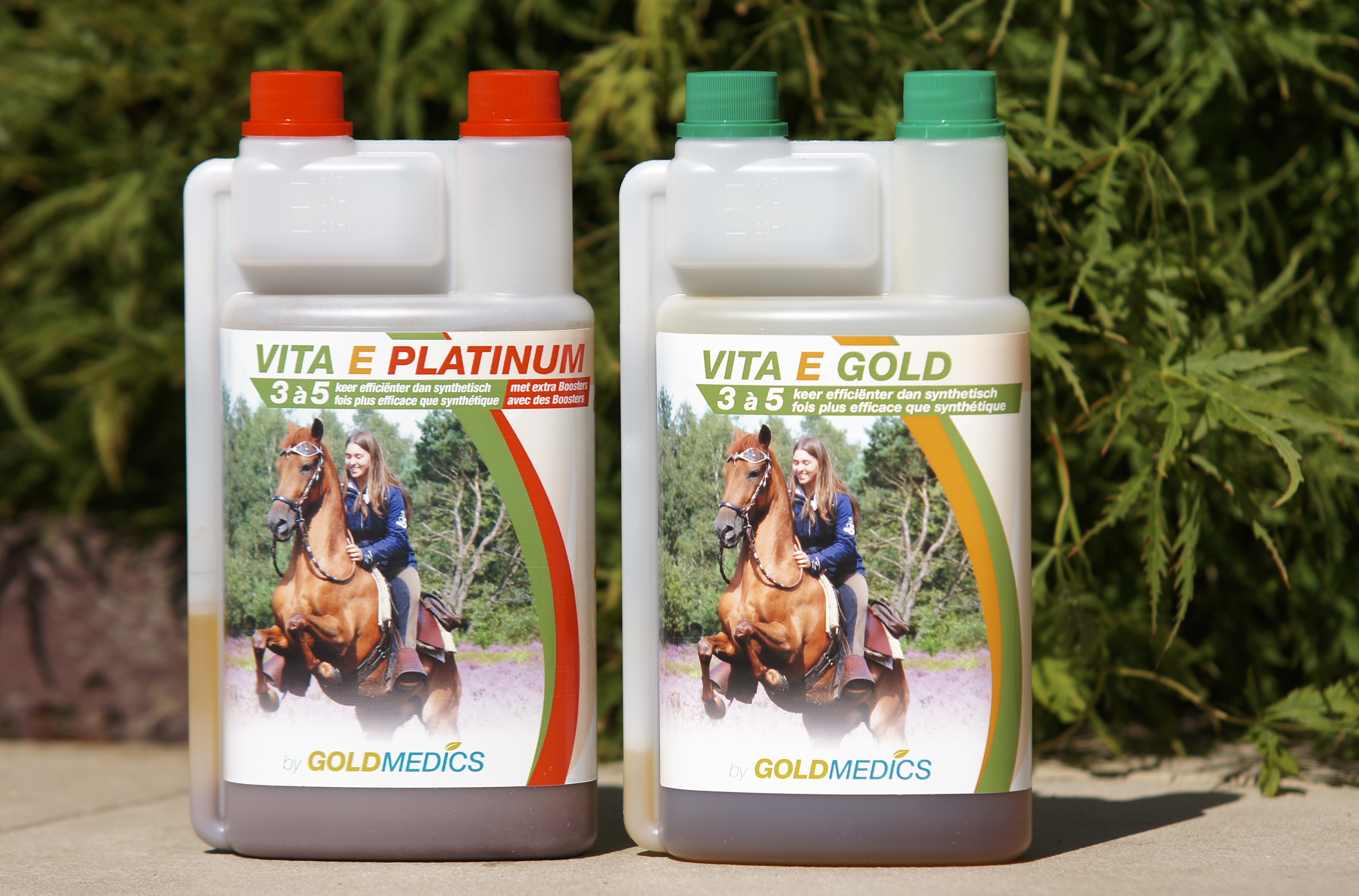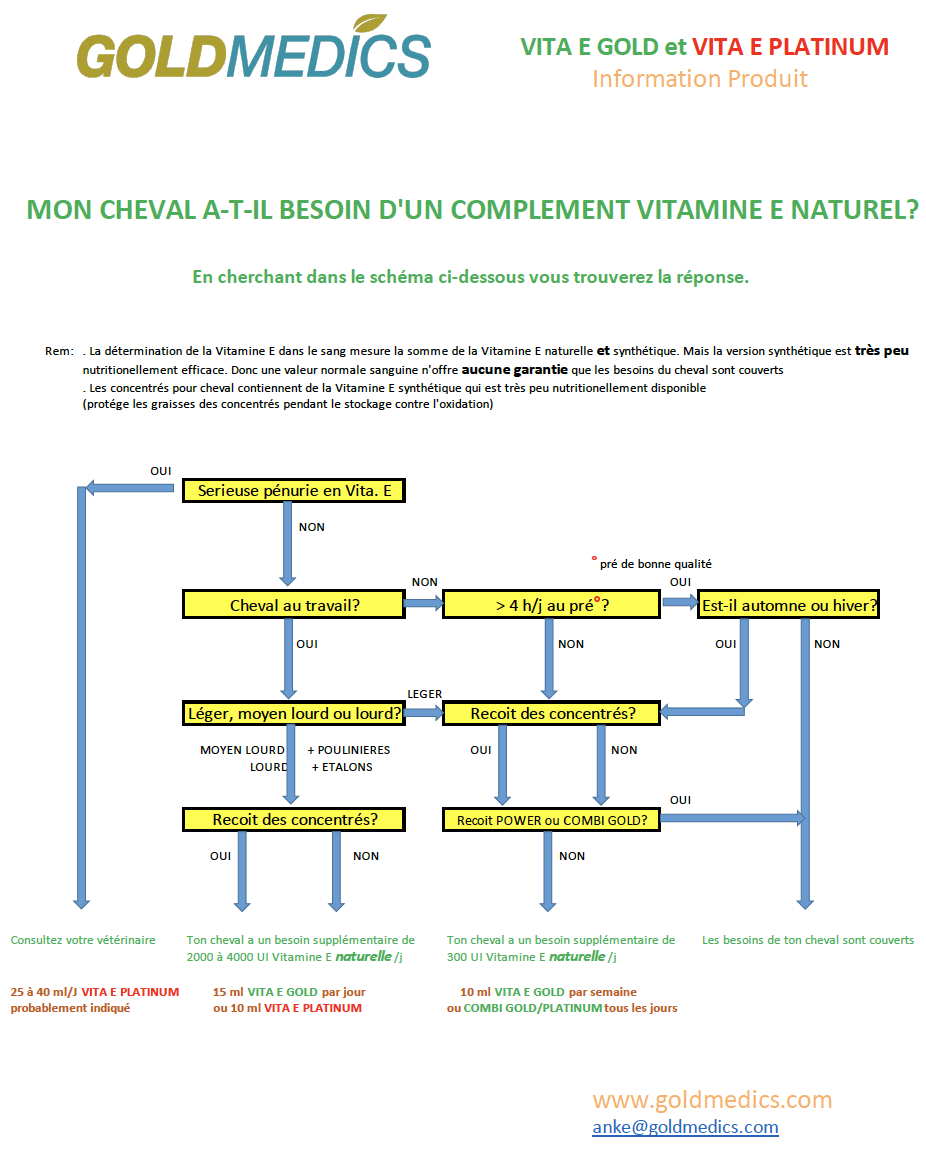Natural Vitamin E for horses: VITA E GOLD and VITA E PLATINUM
€ 38,75 - € 430,00
Ordered on weekdays before 22h, shipped the same day
First choice of veterinarians
Description
Natural Vitamin E for horses: VITA E GOLD and VITA E PLATINUM
There is a high probability that you horse needs a Natural Vitamin E supplement!
GOLDMEDICS is thé solution if you do not want to use pharmaceuticals; moreover, the products are only available through your vet or on this GOLDMEDICS shop!
DO THE TEST: You can easily determine whether your horse needs a natural vitamin E supplement by clicking on the 2nd image and by answering the questions. AND PAY ATTENTION: Determination of the Vitamin E level in the blood does not give an accurate value for the amount of bio-active Vitamin E. The analytical method determines the sum of both natural (active) and synthetic (very little active) content. That is why veterinarians often notice problems and clinical Vitamin E deficiencies on a horse, but do not find too low blood values !! VITA E GOLD and VITA E PLATINUM are liquid, easily administrable and particularly bioavailable forms of natural Vitamin E: RRR alpha tocopherol (D alpha tocopherol). Unlike most supplements of natural vitamin E, it also contains all other tocopherols in the Vitamin E group. Moreover, it also contains a large dose of omega 3 fatty acids. Selenium is also deliberately not added to prevent harmful overdose in the diet. VITA E GOLD contains by far the highest concentration of natural vitamin E tocopherols (400 grams per liter = 40% !!) on the market. Moreover, VITA E PLATINUM contains additionally a whole series of Vitamin E boosters and synergistic ingredients. The choice between the two is simplified with the checklist in Figure 3.What is Vitamine E?
Vitamin E is actually a collective name for a group of naturally occurring isomers, 4 tocopherols and 4 tocotrienols; each with their specific related properties. The most famous is RRR alpha tocopherol (D alpha tocopherol). It is important to know that the other isomers also have useful biological effects and that it is an advantage to supplement the entire group as overdosing of only one form can reduce the uptake of the other forms.What is the function of Vitamin E?
Vitamin E ensures that muscles, nerves and many internal processes in the horse can work optimally. The most well-known function of Vitamin E is as an antioxidant, namely neutralizing the excess of harmful free radicals, which damage cell walls, DNA and other vital structures. An excess of free radicals, for example, arises spontaneously in the horse's muscles simply during movement, and increasingly during intensive training. Nerve and immune cells - i.e. cells that consume a lot of energy - are also protected by Vitamin E. With deficiencies of Vitamin E in horses in training, chances are that muscle pain and a slower recovery will occur. Neuromuscular problems, which are linked to vitamin E deficiencies, can lead to muscle mass loss, muscle cramps during or after exercise and nerve problems. Vitamin E is also, among other things, necessary for correct muscle building.Why Natural Vitamine E?
In most supplements the synthetic racemic mixture all-rac-tocopherol (DL alpha tocopherol; 3a700) is used for cost price reasons, of which only a limited part is biologically active (in horse-plasma one finds 60% to 70% less than with natural vitamin E; it may be assumed that the activity in the cells themselves is more at minus 70 to 85%). Vitamin E is fat-soluble and is stored in liver and body fatty tissue. So the amount that is not used immediately can be stored for later use when the amount of Vitamin E in the food becomes insufficient.Why liquid Vitamin E?
The bioavailability of Vitamin E also depends on the physical form in which it is incorporated. Liquid forms, such as in oil, and the use of coated forms increase availability. The photo (4th image) shows the differences in physical form between powdered Vitamin E that is kept in oil or water on the left and right of the photo for 20 hours at the body temperature of the horse compared to VITA E GOLD. The powder form does not go into solution, which impedes their absorption into the body.What are the Vitamin E sources in the horse's diet (see also graph)?
The Vitamin E group is abundant in fresh, green grass, but the amount is reduced as the grass matures and dies. Point of attention: Even in hot and very dry summers, the Vitamin E content in grass drops considerably !! During production and storage of roughage (hay, etc.) 30 to 80% is further lost. In a study of alfalfa, for example, 73% of Vitamin E was lost after just 3 months of storage. Usually the Vitamin E in concentrates is synthetic for cost price reasons and therefore has a low bioavailability. Moreover, it is largely consumed in the concentrate itself to prevent the oxidation of the fats present.What are the Vitamin E needs of the horse?
The basic requirement for Vitamin E for horses in light work is at least 500 IU (International Units) / day. Horses in intensive training have a higher requirement of 1,000 to 4,000 IU per day. In the case of health problems (allergy, tying up, metabolic syndrome, insulin resistance, hoof seizure, etc.) quantities of 5000 IU and more are indicated. 1500 to 5000 IU for rehabilitation after surgery, illness or stress. Excessive amounts (>>10,000 IU) can lead to interference with the intake of Vitamin A in stabled horses. Fresh green grass contains 5 to 15 IU Vitamin E per kg; if a 500 kg horse in the most productive grass-growing months would eat only grass, we come to a Vitamin E intake of 225 to 1000 IU / day (This means that every horse has 0.3 Ha available during that period and that the grass grows sufficiently). However, if for example one third of the roughage consists of hay, the daily intake can quickly fall to 150 to 850 IU or lower. If in the winter months only hay or pre-dried food is fed and the Vitamin E stored in the horse is used up, we will quickly come across Vitamin E deficiencies even if we only take basic needs into account and supplementation absolutely necessary. With increased needs (see above) supplementation is clearly indicated at all times. VITA E GOLD is the product of choice for regular and acute needs; 3 g of natural Vitamin E alpha tocopherol (4750 IU) and 8 g of natural Vitamin E alpha, beta, gamma and delta tocopherols are dosed per 20 ml. VITA E PLATINUM is indicated for acute needs. In addition to all the ingredients of VITA E GOLD, VITA E PLATINUM also contains Vitamin E boosters and synergistic ingredients. The boosters are: Coenzyme Q10, Vitamin C ester and water and fat-soluble grape polyphenols, boosting the natural Vitamin E content to an equivalent of 9,500 IE per 25 ml. The effect of these boosters has been extensively described scientifically. When the Vitamin E has fulfilled its role and has been converted into an inactive form, they succeed in converting the molecule back into the active form. Furthermore, VITA E PLATINUM also contains rice phytosteryl ferulates, of which a synergistic activity with Vitamin E has been demonstrated. And finally, the tocotrienol content (one of the other active forms of natural Vitamin E) is ten times higher than in VITA E GOLDNew and affordable to use every year from September:
an amount of Natural Vitamin E for 1 year (!) if you meet all 5 of the following criteria: 1. It only covers the need of one horse 2. Your horse has had unlimited pasture with good grass in the spring 3. Your horse does no or only light work 4. Your veterinarian suspects no Vitamin E deficiency externally (a "normal" level of vitamin E in blood is a bad indicator for deficiencies if you give concentrates, because the synthetic Vitamin E in concentrates is also measured and gives an incorrect indication about a normal content) 5. You do not give your horse Power Gold or Combi Gold / Platinum from GoldMedics (because these already contain a sufficient basic amount of natural Vitamin E) In this case, the Vitamin E supply in your horse is probably used up in September and you will end up in the danger zone. A dose of 10 ml of Vita E Gold per week is recommended to start every year as from September. If you only start in January, it is recommended to first start 2 weeks with 10 ml every 2 days followed by 10 ml per week. If you start in March (and your veterinarian sees no problem visually) then the first 4 weeks 10 ml every 2 days followed by 10 ml per week. GoldMedics is now launching a low-cost 250 ml package of VITA E GOLD (identical composition with the 1L package). With 250 ml you help your horse maintain its Vitamin E for a whole year and you avoid all problems (sometimes very serious) associated with Vitamin E deficiencies. Content of the bottles: 250 ml, 1l and 5L for VITA E GOLD, 1L for VITA E PLATINUM; 5L is also available on request info@goldmedics.com : And finally: We are happy to inform you further via info@goldmedics.com or by phone. GOLDMEDICS Dr. Anke Smits +32 495 596 531 Dr. Georges Smits +32 475 490 760 Dr. Filip De keersmaecker +32 475 455 452In need of personal support or information?
Call us: +32 495 59 65 31 of +32 475 490 760
Or e-mail us (we respond 7/7 within 12 hours)




